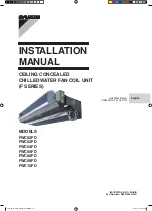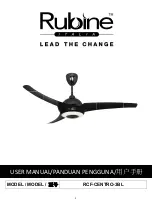
FAN BEARINGS:
1. Lubricate fan bearings per bearing manufacturer’s instructions in the
packet attached to the fan. The fan is shipped with premium quality
lithium based NLGI #2 grade grease. Continue to use NLGI #2 unless
the bearing manufacturer’s instructions specify a different type of
grease for your application. Lubricate bearings immediately upon
receipt. Add enough grease to cause slight purge at seals. It is
common for bearings to purge excessive grease during first 24 to 48
hours of operation. See bearing manufacturer’s instructions enclosed
for lubrication schedule.
2. Bearing must be properly locked to the shaft. Check before operation.
Make sure bearing locking collar is in position and set screws are tightened
to the bearing manufacturer’s recommended torque levels. See bearing
manufacturer’s instructions enclosed for details. The bearing set screws
should be re-torqued after eight and twenty-four hours of operation.
VERTICALOPERATION:
If the fan is to operate with its shaft vertical, reset the bearings as
follows
a. With the shaft vertical, unlock the drive end bearing set screws
and turn the shaft by hand. This allows the wheel end bearing to
take the gravity load of the shaft and wheel.
b. Re-lock the drive end bearing locking device and replace and torque set
screws as required by the bearing manufacturer’s instructions so that
this bearing now takes only the belt pull.
FANS WITH COUPLINGS:
On any completely assembled fan, where CBC has mounted the motor
and coupling, it is required that the alignment be rechecked after the fan
is set on its permanent foundation. It is not possible to hold alignment
during shipment or when set on a different foundation. Coupling must be
realigned and lubricated per manufacturer’s instructions sent with the fan.
V-BELT DRIVES:
1. Alignment of the drives must be checked with a straightedge or string.
Belt tension must must be properly adjusted to assure good belt and
bearing life. Sheave faces should be parallel and aligned within 1/16".
Use balanced sheaves.
2. With all belts in their proper grooves, adjust the centers to take up all
slack and until the belts are fairly taut.
3. It is normal on v-belt drives handling more than 20 HP to “squeal” on
start-up.
Do not tighten belts too tight.
Normal belt tension can be
determined by being able to depress belt, at mid-point a distance
equal to one belt width, with normal finger pressure.
4. After a few days operation the belts will seat themselves in the sheave
grooves and it may become necessary to readjust so that the drive
again shows a slight “bow” in the slack side. The drive is now properly
tensioned and should operate satisfactorily with only an occasional
readjustment to compensate for belt and groove wear.
OPERATION OF FAN:
After installing the fan per these instructions and the instructions of the
manufacturers, make final safety checks to prevent injury to personnel
or damage to the equipment.
Always block rotating parts to prevent
windmilling while inspecting the fan.
1. Lock power source in “OFF” position.
2. Check bearings for alignment and proper lubrication, with wheel and
inside of the housing clean and free of debris.
3. Check wheel position for proper clearance and rotation. Unblock rotat-
ing parts and turn wheel by hand to insure that it rotates freely.
4. Check sheave set screws or bushings and wheel set screws for tight-
ness. If fan is a HEAT FAN, check to see that the shaft cooling wheel
bolts are tight. Check foundation bolts. Secure safety guards and
access doors.
5. If fan is designed for low density (such as high temp), make sure over-
load of fan motor is avoided if fan is run with standard air.
6. Start fan and allow unit to reach full speed, then shut down. During
this short period, check for rotation, excessive vibration, any unusual
noise, or overheating of the motor. Check the motor amps drawn
against the nameplate rating. A plate over the fan inlet will limit the
horsepower drawn during a test run with limited ductwork.
7. After the trial run lock the power “OFF”.
8. Recheck for tightness of hold-down bolts, wheel set screws and keys,
and retighten if necessary. Recheck after eight and twenty-four hours
of operation.
9. The run-in period should be at least eight hours. Check bearings a
minimum of once each hour during this period. Overgreasing may
cause bearings to heat up. There need be no concern if the bare hand
can be held on the bearings briefly. Bearings will vent extra grease
and cool down after start-up. Recheck torque of all bearing set
screws after eight and twenty-four hours of operation to insure levels
are maintained per the bearing manufacturer’s recommended levels.
Take vibration readings at the bearings, or the motor bearings if
the fan wheel is mounted directly on the motor shaft. Adhere to these
limits. Velocity limits in inches/second – Normal: 0.15; Alarm: 0.22;
Shutdown: 0.50
MAINTENANCE:
To insure long life and trouble-free service, frequently check all bearing
lubrication. See the bearing manufacturer’s instructions packed with the
fan. Should excessive vibration develop, check the following possibilities:
1. Build-up of dirt or foreign material on the wheel.
2. Loose bolts on bearings, housings, foundation and drive.
3. V-belt drive improperly aligned. Belts must have proper tension,
sheaves must be balanced.
4. Check wheel set screws.
5. Foreign matter may have entered fan causing damage to wheel, shaft
or bearings.
6. Vibration may be coming from a source other than the fan. Stop the fan
and determine if the vibration still exists. Disconnect the driver from the
fan and operate it by itself to determine if it produces vibration.
7. Proper clearance between the wheel and the inlet.
A preventive maintenance schedule is a necessity for extending fan life.
Establish a lubrication schedule based on time periods suggested in
lubrication instructions and by motor and bearing manufacturers.
After approximately one (1) month of operation, all base, hub bearing,
pedestal, etc. bolts should be checked.
Potentially damaging conditions are often signaled in advance by
change in vibration and sound. A simple, regular audio-visual inspection
of fan operation leads to correction of the condition before expensive
damage occurs. Vibration levels should be check by an approved tech-
nician using electronic balancing equipment.
If air handled by the fan contains corrosive, erosive or sticky materials,
fan should be shut down regularly for inspection, cleaning and recondi-
tioning of interior parts.
If the fan is to remain idle for an extended period, fill bearing with grease.
Protect motor and exposed surfaces. Follow the motor manufacturer’s
recommendations for storage and rotate the shaft by hand several revo-
lutions each month.
Mechanical Integrity:
Certain operating conditions reduce the built-in
strength in the fan impeller and may cause unsafe operation. It is the
user’s responsibility to inspect for these conditions as frequently as nec-
essary and make corrections as required. Failure to comply with the fol-
lowing limits voids the Chicago Blower Corporation warrant.
Maximum Safe Speed and Temperature:
Operation exceeding maxi-
mum safe RPM and temperature even for a short time causes over-
stressing or fatigue cracking of the impeller resulting in unsafe condition.
Maximum safe speed and maximum safe temperature are shown on fan
assembly drawings, catalogs or order acknowledgement.
(continued from previous page)
Warranty:
The warranty on Chicago Blower fans is our standard warranty. The warranty on the motor is that extended by the motor manufacturer.
10.






















